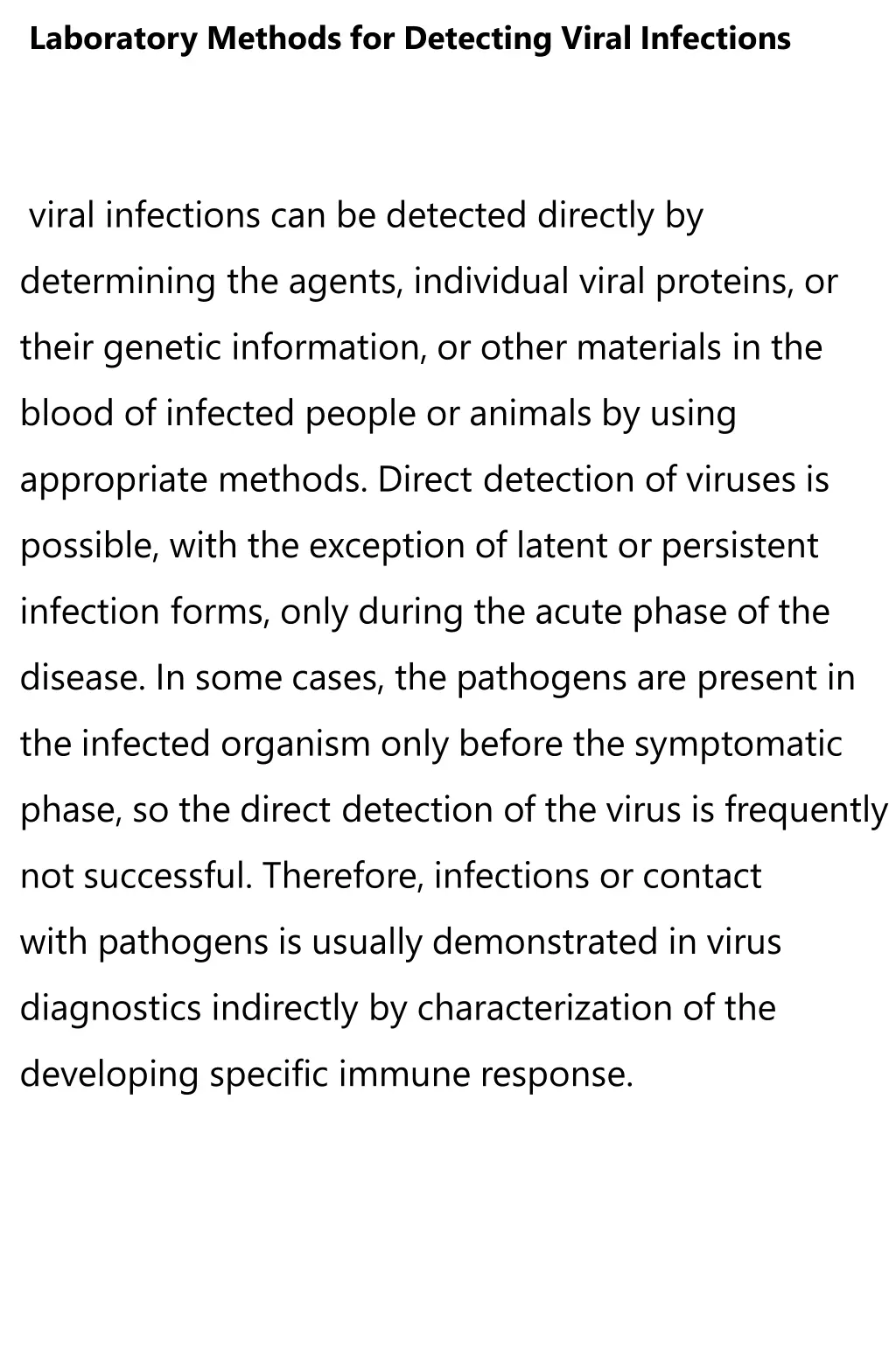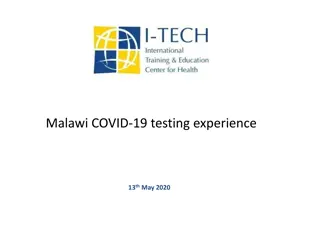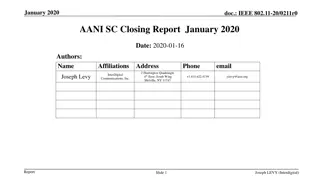
Detection Methods for Viral Infections and Cultivation Systems
"Learn how viral infections are detected directly through viral cultivation and detection systems using laboratory methods. Explore the process of viral cultivation in cell lines and the use of primary cell lines in detecting human pathogenic viruses. Discover the role of protein detection techniques such as Western blotting in identifying specific viral antigens."
Download Presentation

Please find below an Image/Link to download the presentation.
The content on the website is provided AS IS for your information and personal use only. It may not be sold, licensed, or shared on other websites without obtaining consent from the author. If you encounter any issues during the download, it is possible that the publisher has removed the file from their server.
You are allowed to download the files provided on this website for personal or commercial use, subject to the condition that they are used lawfully. All files are the property of their respective owners.
The content on the website is provided AS IS for your information and personal use only. It may not be sold, licensed, or shared on other websites without obtaining consent from the author.
E N D
Presentation Transcript
LaboratoryMethodsforDetecting ViralInfections viralinfectionscanbedetecteddirectlyby determining theagents,individualviralproteins,or theirgeneticinformation,orothermaterials inthe bloodofinfectedpeopleoranimalsbyusing appropriatemethods.Direct detectionofvirusesis possible,withtheexceptionoflatentorpersistent infection forms,onlyduringtheacutephaseofthe disease.Insomecases,thepathogensare presentin theinfectedorganismonlybeforethesymptomatic phase,sothedirect detectionofthevirusisfrequently notsuccessful.Therefore,infectionsorcontact withpathogensisusuallydemonstratedinvirus diagnosticsindirectlybycharacterizationofthe developingspecificimmuneresponse.
HowCanVirusesBeDetectedDirectly? ViralCultivationandDerivedDetectionSystems Forthecultivationandpropagationofmostviruses, continuouslygrowingcelllines areavailabletoday. Thepreferentiallysterilepatientmaterialtobe investigated,such as blood,serum,pharyngeal lavage or urine, is freed from raw impurities and incubated withthecellsinasmallvolume.Inthefollowingdays, the cellsaremicroscopicallycheckedfor morphologicalchanges,suchastheappearance ofcytopathiceffects,plaquesinthecelllayerdueto celldeath,inclusionbodiesand giantcells,which allowaninitialinferenceonthereplicatingvirus,and alsoserveasevidencethatinfectiousviruseswere presentinthestartingmaterial.
Primarycelllinesarebarelyusedforcultivationofhumanpathogenic viruses today.Theyhaveonlylimiteddivisioncapacity;therefore,they mustberepeatedly established.Anexceptionisforeskinfibroblasts, whichareoccasionallyusedfor cultivationofherpessimplexvirus. Particularly,theroutineuseofembryonicstem cells,whichpossess increaseddivisioncapacity,ishighlyregulated.Inveterinarymedicine, primary celllinesarecommonlyusedinexceptionalcasesforthe cultivationofcertain pathogenicvirusesinpoultryvirology.Incertain cases,theyareevenusedfor vaccineproductionaswell. Theformerlywidespreadviralcultivationinembryonatedchickeneggs isno longerusedroutinely.Itisonlyusedincertaincases,suchasthe cultivationofnew influenzavirusisolatesorforvaccineproduction
Theclassicformofviralcultivationusually involvesarelativelylongincubation periodof1 4weeks.Ashortenedversionisthe shellvialassay.Thisprobablyaltersthefluidityof thecytoplasmic membraneofthecells,thus leadingtofasterpenetrationofthepathogens. After incubationfor1 2days,viralproteinscan bedemonstratedinthecellsbymeansof immunofluorescenceorsimilarprocedures.
ProteinDetection WesternBlotting Onewaytodeterminethetypeofvirusisthe identificationofspecificviralantigens inWestern blottests.Forthispurpose,theproteinsof infectedcellsorvirus particleswhichwere previouslypelletedbyultracentrifugationare separatedby electrophoresisonasodiumdodecyl sulphate polyacrylamidegel.Theirpattern and molecularmassescanprovideevidenceforthe typeofvirus.However,afinal assignmentisonly possibleserologicallyintheWesternblot(Fig.13.1). Forthis purpose,theseparatedproteinsare transferredfromthepolyacrylamidegelto a nitrocelluloseornylonmembrane(actualWestern blot)andthenincubatedwith antiseracontaining immunoglobulins,whichspecificallyreactwiththe viralantigensofinterest(primaryantibody).
Fig.13.1Exampleforthedetectionofviralproteins.(a)Sodiumdodecylsulphatepolyacryl-Fig.13.1Exampleforthedetectionofviralproteins.(a)Sodiumdodecylsulphatepolyacryl- amidegel.ProteinextractsfromEscherichiacolibacteriaexpressingdifferentregionsofaprotein ofparvovirusB19wereelectrophoreticallyseparatedandstainedwithCoomassieblue.Allpro- teinspresentinthepreparationexhibitabluecolour(hereinblack).(b)Westernblot.Theprotein bandsofthesodiumdodecylsulphate polyacrylamidegelshownin(a)weretransferredto anitrocellulosemembrane(Westernblot)andthenincubatedwithrabbitpolyclonalantibodies thatspecificallyrecognizetheparvovirusprotein.Afterawashprocedure,themembranewas treatedwithsecondaryantibodiesthatareconjugatedwithhorseradishperoxidase(immunoglob- ulinsfromswine,whicharedirectedagainsttheFcregionofrabbitantibodies)andspecifically bindtotheboundprimaryantibodies.Subsequently,themembranewasincubatedwith diaminobenzidinesolutions.Intheareaofproteinbandstowhichtheantibodycomplexeshave bound,abrownprecipitateisproducedindicatingapositiveresponse
AntigenELISA ThisvariantofELISAisemployedfordetectingviralproteinsorparticlesasan alternativetotheanalyticalWesternblot.Thetestisusuallyperformedin microtitre plateswhichcontain96wellsandaremadefromspeciallytreated polystyrene. Murinemonoclonalantibodiesagainstaspecificviralproteinareboundto the surfaceoftheplasticwells.Thereafter,suspensionswhichcontainthe virusin questionortheviralproteinsofinterestareaddedthewells.Ifthe relevantantigens arepresent,theywillinteractwiththepolystyrene-bound immunoglobulins.The antigen antibodycomplexescanbedetectedinthenext stepbyadditionofafurther antibody,whichbindstoadifferentepitopeof thesameviralprotein.These immunoglobulinsarecovalentlyconjugated withhorseradishperoxidase,sothe complexcanbevisualizedbythe additionofo-phenylenediamineasasoluble substrate.Photometric measurementoftheintensityofthischromaticreaction makespossiblea quantitativeorsemiquantitativedeterminationoftheviralantigen, whichwaspresentinthestartingmaterial(Fig.13.2a).
Immunofluorescence Directimmunofluorescenceisusedtoinvestigatewhethervirusproteins areproducedininfectedcells.Thecellsaredroppedonslides,fixed andtreatedwith alcoholicsolventstorendercellmembranespermeable. Thereafter,theyareincubatedwithimmunoglobulinsdirectedagainstthe viralproteinstobedetected.The followingtreatmentwithsecondary antibodies,whicharedirectedagainsttheFc regionofthepreviously usedimmunoglobulinsandlinkedwithfluorescentcompounds(e.g. fluoresceinisothiocyanate),allowsonetovisualizeviralproteinsin differentcompartments,suchasthenucleus,thecytoplasmandthecell membranes. DetectionofVirusProperties Somevirusesencodespecificenzymeactivities,whichcanbedetectedas characteristicpropertiesininfectedcells,orassociatedwithviralparticles intheculture supernatant.Theseinclude,forexample,thedetermination ofreversetranscriptase activity, which is produced by human immunodeficiency viruses and is acomponent oftheresultingvirus particles.Onthebasisoftheamountofthis enzymedetectedinthe culturesupernatant,thenumberofvirusparticlesproduced canbequantitativelydetermined
13.1 167 a Positive (yellow) Positive (yellow) Negative (white) Substrate Microtitre plate 1 Virus-specific antibodies bound to the well walls 2 Virus particles from sample material bind to the virus-specific antibodies 3 Virus-specific antibodies against an alternative domain of the virus particle, conjugated with horseradish peroxidase 4 Substrate addition (o-phenyldiamine), in positive cases, it is converted into a yellow compound by the horseradish peroxidase b Positive (yellow) Positive (yellow) Negative (white) Substrate Microtitre plate 1 Virus-specific protein bound to the walls of the wells ( ) 2 Serum from patient contains in positive cases antibodies against the viral protein 3 Secondary antibody against the Fc region of patient immunoglobulins, conjugated with horseradish peroxidase 4 Substrate addition (o-phenyldiamine), in positive cases, it is converted into a yellow compound by the horseradish peroxidase Fig.13.2ThereactionstepsindifferenttypesofELISA.(a)Antigen-captureELISAfor detectingviralproteinsorparticles.(b)ELISAtodetectspecificantibodies
168 13 LaboratoryMethodsforDetectingViralInfections Slide if they are bound, the cellular structures that are recognized by the complex are stained in green because of the fluorescein isothiocyanate (FITC) labelling 1 Infected, fixed cells 2 Specific antibodies, e.g. in sera from patients 3 Secondary antibody against the Fc region of human immunoglobulins; Fig.13.3Thereactionstepsintheimmunofluorescencetest .Othervirusesareabletoagglutinateerythrocytes. Thishaemagglutinationcapacityisfound bothinhumanpathogenicandinanimal pathogenicviruses.Itisassociatedwithviralenvelope proteins,andhencewiththe virions.Therefore,haemagglutinationtestscanbeperformed, amongothers,with paramyxovirusesandorthomyxovirusesaswellaswith flaviviruses, togaviruses,coronavirusesandparvoviruses.Erythrocytesofappropriatespeciesareused andmixedwith thevirus-containingsuspensions;ifredbloodcellsagglutinate,thisindicates the presenceofviruses.Ifthereactioncanbeinhibitedbyaddingvirus-specificantibodies, then this so-called haemagglutination-inhibition test allows determination of thevirustypeinthe startingmaterial.However,thismethodhasbecomeobsoletein routinediagnosis.
13.1.1.2DetectionofViralNucleicAcids Alternativelytoproteinsorenzymeactivities,viralnucleicacidscanbe isolated frominfectedcellsandspecificallyanalysedbySouthernblot, Northernblotordot-blottests.ThepurifiedDNAiscleavedby restrictionenzymes.Theresulting fragmentsareseparatedaccordingto theirsizebyagarosegelelectrophoresis. Subsequently,DNAfragmentsaretransferredfromthegeltoa nitrocelluloseor nylonmembrane(Southernblot);thesameisdonefor detectionofviralRNA (Northernblot),butomittingcleavagewith restrictionendonucleases.TheDNAor RNApreparationscanalsobe spotteddirectlyonthemembrane(dotblot).Inthe caseofdouble-stranded nucleicacidmolecules,adenaturationstepisrequiredtogeneratesingle- strandedmolecules.Subsequently,thenitrocelluloseornylon membraneisincubatedwithlabelledsingle-strandedDNAorRNAprobes which arecomplementarytothenucleotidesequencesexaminedand hybridizewiththem, formingdouble-strandedmolecules.Whereasthe hybridizationreaction wasformerlydoneusingmainlyradioactive nucleotidescontaining32Por35S,
HowCanVirusesBeDetectedDirectly? Separation of the DNA fragments that arise following restriction enzyme treatment by means of agarose gel electrophoresis Double-stranded cellular DNA fragments Double-stranded viral DNA fragments Agarose gel Transfer to a nitrocellulose membrane and denaturation into single strands Nitrocellulose membrane Single-stranded DNA Incubation with labelled single-stranded DNA probes that are complementary to the viral fragments hybridization with the single-stranded viral DNA probe -> detection and visualization by x-ray film exposure Fig.13.4PrincipleoftheSouthernblottest
non-radioactivesystemsarenowpredominantlyused. Reagentsarecovalently linkedwithenzymesthatfacilitatedetectionbyacolorimetricreaction.The intensity of the colour is directly proportional to the quantity of viral nucleic acid on the blot. DirectDetectionofVirusesinPatientMaterial
HowCanVirusesBeDetectedDirectly? 171 Control window immobilized anti-IgG antibodies Membrane immobilized virus-specific antibodies Sample application window: gold beads coated with virus-specific IgG Results window: Gold beads ( 20 m) Application ofthesample tobeexamined The virus binds to the gold beads that are coated with virus-specific IgG Flow direction Flow direction Virus-negative sample Virus-positive sample Incubation Migration of the complexes from the sample application window Anti-IgG antibodies bind to virus-specific antibodies gold bead complexes Virus-specific antibodies bind to the virus-IgG Gold beads generate a visible band in the control window Gold beads generate visible bands in both the results and the control window Fig.13.5Immunochromatography(rapidtestfordetectionofvirusesinpatientmaterial).This testisaimedatdetectingvirusesinliquidpatientmaterials,suchasserum,sputumand stoolsamples.Membranesareused(nitrocelluloseorsimilar)whicharecoatedwithspecific reagentsindifferentsections(windows).Sampleapplicationwindow:largequantitiesofgold
Fig.13.5(continued)beads(diameter20mm)containcovalentlyboundIgGantibodiesontheFig.13.5(continued)beads(diameter20mm)containcovalentlyboundIgGantibodiesonthe surface,whichbindspecificallytoepitopesonthesurfaceproteinsofthepertinentvirus.Results window:IgGmoleculesarecovalentlyboundtothemembrane,andcanbindtothesameor differentepitopesofthevirustobedetected.Controlwindow:thiscontainsanti-IgGantibodies covalentlyboundtothemembrane.Thetestprincipleisasfollows.Themembraneisincubated withthebiopsymaterialintheareaoftheapplicationwindowandplacedinacontainerwithbuffer solution.Ifthematerialcontainsthevirusinquestion,thentheviruswillbindtotheIgGantibodies onthegoldbeads.Virus IgGgoldbeadcomplexesandunloadedbeadsmigratewiththebuffer frontintotheresultswindow.IgGantibodies,whicharecovalentlylinkedtothemembrane,bind tofreeepitopesonthesurfaceofthevirus.Inthisway,themigrationofvirus IgGgoldbeadsis stopped,andtheyformagolden(dark)bandwithintheresultswindow.Theunloaded(virus-free) IgGgoldbeadsmigratefurtherwiththebufferfrontintothecontrolwindow,wheretheirmigration isstopped,astheyreactwiththeimmobilizedanti-IgGantibodies.Asaresult,asecondbandarises inthecontrolwindow.Fromthestrengthofthebandsandtheirratio,itispossibletoinferthe amountofvirusinthestartingmaterial.Ifthetestmaterialdoesnotcontainanyviruses,onlyone bandwillbeformedinthecontrolwindow
PolymeraseChainReaction Thepolymerasechainreaction(PCR)allowstheamplificationofverysmall quantitiesofviralgenomesortranscriptsdirectlyfrompatientmaterial. Theoreticallyandpractically,itispossibletodetectevenasinglenucleicacid moleculein thetestsample.Twooligonucleotides(primer)mustbeselected (15 20 nucleotidesinlength)thatarecomplementarytoeachstrandofthe double-stranded DNA,flankingaregionof200 400bases(inreal-time PCRalsosignificantly shorter).TheDNAisconvertedintosinglestrandsby heatdenaturation(usually at94C).Subsequently,theprimersareadded inhighmolarexcess,andthey hybridizewiththerespectiveDNAstrands duringannealingandformshortdouble-strandedregions(annealing,usually at50 60C).Thereactionmixturealso containsaheat-stableformof DNApolymerase(usuallyTaqpolymerasefrom thethermophilicbacterium Thermusaquaticus)andthefournucleosidetriphosphatesdATP,dGTP,dCTP anddTTPinappropriateconcentrationsandbuffer systems.Thehybridized oligonucleotidesfunctionasprimers.Theyprovidethe necessaryfree30-OH ends,ontowhichtheTaqpolymerasesynthesizesthecomplementaryDNA sequence(elongationorchainextension,usuallyat72C).This stepcompletes thefirstcycle.Asaresult,twodouble-strandedDNAmoleculesare presentin thereactionmixture,whichareseparatedagainbyashortheatdenaturation step,whichinitiatesthesecondcycle.Duringthefollowingannealing,
oligonucleotideshybridizeagainwiththesinglestrandsandserveasaprimeroligonucleotideshybridizeagainwiththesinglestrandsandserveasaprimer for thesynthesisoffurtherdoublestrands:thus,theoriginalDNAmoleculehas been amplifiedinachainreactiontofourdouble-strandedmolecules.The cyclesare repeatedasoftenasdesired,achievingalogarithmicamplificationof nucleicacid molecules(2n,nisthenumberofcycles;Fig.13.6).Afterabout30 40cycles,the logarithmicamplificationphaseendsowingtodepletionof reagentsandenzyme; thePCRamplificationproductscanbeseparatedby agarosegelelectrophoresisand visualizedbystainingwithethidiumbromide. theresultingfragmentcanbeidentifiedaccording toitssizeafterseparationof thereactionmixturebyagarosegelelectrophoresis,or byasubsequent Southernblotassay;SinceDNAisverystable overlongperiodsoftime,its sequencescanbedetectedinolderandeveninfixed tissuesamples.Therefore, virusescanbedetectedinveryold,formaldehyde- conservedsamplesand eveninembalmedmummies. IftheoriginalnucleicacidisRNA,itisprimarilyconvertedintosingle- stranded DNAusingareversetranscriptaseandanappropriateprimer.Thisis followedby theamplificationreactionsdescribedabove.
Nowadays,thereareautomatedtestsystemsthatallowquantitative determinationofviralnucleicacidsinthestartingmaterial(real-timePCR). Forthispurpose, theDNAorRNAmoleculesareamplifiedasdescribed above.Adefinedsetof single-strandedprobeswhichhavealengthof25 40 nucleotidesandarecomplementarytosequencesoftheamplifiedregions areaddedtothereactionmixture. Thesesequence-specificprobesare labelledwithafluorescentgroupatthe50 terminus(e.g.6- carboxyfluorescein).Conversely,theycarryadifferentchemical
Fig.13.6Principleofthe polymerasechainreaction 5 3 Double-stranded viral DNA Heating denaturation 3 5 5 3 3 Annealing hybridization of oligonucleotides in excess 5 5 3 5 5 3 3 5 Polymerization 5 3 5 5 3 5 Heating denaturation 5 3 3 5 5 3 Annealing hybridization of oligonucleotides and polymerization 3 5 5 3 5 5 3 5 3 5 3 5 Repetition of the steps Logarithmic amplification
Ifviralgenomesarepresentin thesample,thenthenucleotidesofthe probearedegradedbytheexonuclease activityofTaqpolymeraseduringthe polymerizationprocess. The moreviralnucleicacidwasinthestartingmaterial,thehigheristhe fluorescence intensity.Commonprocedureshavealogarithmicamplification efficiencyofsixto eightlogarithmicmagnitudes.Withuseofseveralprimer pairsanddifferentially labelledprobes,variousamplificationproductscanalso bedetectedspecifically andquantitativelyinasingleassay(multiplexPCR). Thus,internalcontrolsare possibleforcheckingboththeDNAextraction efficiencyandpossibleinternal inhibitions.Anotheradvantageofreal-time PCRisthesignificantlyreducedriskof end-productcontamination. InSituHybridization Infrozensectionsofinfectedcellsortissues,suchasinpathology,viralDNA and RNAcanbedetectedbyinsituhybridizationwithspecific,labelledDNAor RNA probesthatarecomplementarytothetargetsequence.Usually,the probesare labelledwith3H-thymidineorbiotinylatednucleotide derivatives.Inthefirst case,afterhybridization,thefrozensectionsarecoated withafilmemulsionand subsequentlydeveloped,wherebyagranular blacknesscanbeobservedinthe infectedcellsbymicroscopic examination.Thismethodcanbecombinedwith PCR,soevenminute amountsofviralnucleicacidscanbedetectedinfrozen sections(insitu PCR).
SpecificImmuneReactionsUsedfortheIndirect DetectionofViralInfections. IgM antibodiesgenerallyindicateanacuteorrecentinfection.Bycontrast,if IgG antibodiesagainstaspecificvirusaredetected,apastorformerinfectioncan be inferred.Theyarealsoindicativeofanimmunestatuswhichprotectsthe person fromanewinfectionwiththesamepathogen.Especiallyfordiagnosis of acuteinfections,itisimportanttodeterminetheconcentrationofIgMandIgG antibodiesduringinfection.Occasionally,onealsotestsforIgAantibodies.All antibodiescanbedetectedbyWesternblot,ELISAorindirect immunofluorescence analyses.Sometimes,thehaemagglutination-inhibitiontest isalsoused.Ifspecific functionsaretobeassociatedwithimmunoglobulins, suchastheirabilityto neutralizethecorrespondingvirus,thenoneexamines whethertheimmunoglobulinscaninhibittheinfectioninvitro.
IndirectImmunofluorescenceTests Forthispurpose,invitroinfectedculturecellsaredepositedandfixedon slides.The serumdilutionstobetestedareaddedtothecellsandbound antibodiesaredetected byusingfluoresceinisothiocyanateconjugated immunoglobulinsthat,depending onthequestiontobeanswered,aredirected againstIgGorIgMofthespecies examined. TestSystemsforDetectionoftheCellularImmuneResponse .Thetest systemsusedareconsiderablymorecomplexthanthoseemployed forthedetection ofspecificantibodies.Inthefirststep,Tlymphocytesmustbe isolatedfromthe bloodofthesubjectsbydensitygradientcentrifugation(e.g. Ficollgradient)or enrichedbylysisoferythrocytes.Thefurtherpurification ofthedifferentcell populationsisperformedbybindingofcellstomagneticbeadscoatedwith specificantibodies(e.g.directedagainstCD4orCD8receptorsonthesurfaceof T-helper cellsandcytotoxicTlymphocytes).Alternatively,thecellscanbelabelledwith specificantibodiesdirectedagainstcertainsurfaceproteinsandthenisolated by fluorescence-activatedcellsorting(FACS).Inthesecondstep,therespectiveT- cell populationsareanalysedintests. Thelymphocyteproliferationorstimulationtestisusedfor detectingspecifically reactivelymphocytepopulations.Inthisprocedure,the isolatedlymphocytesare incubatedwiththeantigensinquestionorwith antigen-presentingcells.Lymphocytes,whichrecognizetheantigeninquestion, begintoproliferate andcanbefollowedbymeasuringtheincorporationofthe radioactivenucleotide intothecellularDNA.
Alternatively,secretedproteins(suchascertaininterleukins),whichareAlternatively,secretedproteins(suchascertaininterleukins),whichare releasedasaresultoflymphocyterecognition,canbedetectedby ELISAintheculturesupernatantorbymeansofenzyme-linked immunosorbent spottestsatthelevelofindividualcells. Theenzyme-linkedimmunosorbentspottestisusedforthe quantitative determinationoflymphocytes,whichproduceandsecrete certainproteins(such asinterleukins,chemokinesandantibodies)asaresult ofspecificantigenrecognition(orrepeatedstimulation).
a Productionoftetramermolecules Fluorescently labelled streptavidine Recombinant HLA class I protein Peptide + viral peptide antigen Streptavidin + Biotinylation Tetramer formation + 2m 2m Biotin Biotinylation signal Fluorescent dye 1 b Detectionofepitope-specificTcellsbyflowcytometry T cell receptors Fluorescence 1 (tetramer) CD8 Tetramer CD8+ cytotoxic T cell Tetramer CD8 FACS analysis CD8 Tetramer CD8 Anti-CD8 antibody Fluorescent dye 2 0 Fluorescence 2 (CD8) Fig.13.7CourseofthetetramertestfordetectionofspecificreactiveTlymphocytes. (a)Productionoftetramericmolecules.RecombinantlyproducedHLAclassIantigensare biotinylatedatacarboxy-terminallyattachedbiotinylationdomainandincubatedwithavirus- specificpeptideantigen(T-cell-specificepitope)andrecombinantlyproducedb2-microglobulin (b2m).FourbiotinylatedHLAclassI/peptide/b2-microglobulincomplexesbindtostreptavidin molecules,whichwerelabelledwithfluorescentdye1,forming tetramers .(b)Detectionof virus-specificTcellsbyflowcytometry.CD8+Tlymphocytesareisolatedfromthebloodof patientsandincubatedwithCD8-specificmonoclonalantibodies,whicharelabelledwithanother fluorescentdye.ThelabelledCD8+Tcellsareincubatedwiththetetramericcomplexes.If Tlymphocytesarepresentwhichrecognizetheviralpeptideantigen,theywillbindtothe tetramericcomplexesusingtheirspecificT-cellreceptor.Onthebasisoftheirfluorescent labelling,theTcellsthatarelinkedtothetetramericcomplexescanbemeasured,quantified anddistinguishedfromthosewithoutcomplexesbyfluorescence-activatedcellsorting(FACS) analyses
MultiplexReactionsandGenotyping Incontrasttothegeneraldetectionofbacterialinfections,e.g.byamplification of bacterial16SribosomalRNA,nogeneralscreeningtestisavailablefor detecting viralinfections.Thisimpliessearchingspecificallyforeach potentialpathogen. Withregardtopracticalityandcosts,theabilitytodetectmultiplevirusesusing asinglePCRwouldbeasolution.Ideally,allpossiblepathogensfordiarrhoea or meningitiscouldbedetectedinasingleassay.TheprincipleofmultiplexPCR takes thisintoaccount,asseveralprimerpairsandprobescanbemixed together. However,thisapproachisgenerallyassociatedwithalossof sensitivity.Anelegant solutioniswhenaconservedregioncanbeamplified withaprimerpair,inwhich thedeterminationofsubtypesorgenotypesis possiblebydifferentprobeswith asufficientnumberofsequencedifferences. Thisprinciplehasbeensuccessfully appliedindeterminingthehigh-gradeand low-grademalignantsubtypesofhuman papillomaviruses.
ResistanceTests Itisoftenimportantto searchspecificallyforthepresenceofwell-known mutationswhichdeterminethe respectiveresistance.InthecaseofHIV, phenotypictestswereinitiallyappliedin whichthevirusinfectingthepatient wascultivatedincellcultureandexaminedfor sensitivitytothecorresponding drugs.Later,itwasattemptedtoinsertthetested genesinrecombinantviruses. But,itismorepracticaltodeterminethepredominant genotypeofthevirus, e.g.byPCRandsubsequentsequencing.InthecaseofHIV, thegenes encodingthereversetranscriptasecomplexandtheviralproteaseare examined.Owingtotheincreasingprevalenceofalreadyresistantvirusesin new infections,thiscanalsobeimportantbeforethefirsttherapy.



















